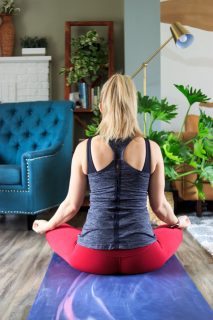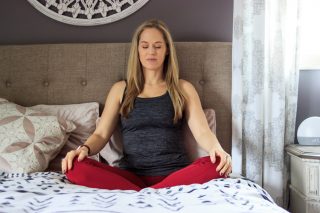By Amber Battishill
Meditation has become more popular over the past few years. For many, meditation is surrounded by a bit of mystery and can feel intimidating to first timers. But, with its immense physical and mental benefits, everyone should give meditation a try! For myself, one of the biggest and most noticeable benefits to meditation has been stress reduction. A regular meditation practice can reduce stress and lead to a clearer mind, better mood and improved physical health. To get started, this meditation guide will help demystify meditation and share ways to weave meditation into your daily routine.

What is Meditation?
Mediation is a practice in which users apply a set of techniques to encourage focused attention, awareness, clarity, and a sense of happiness. Meditation can be incredibly helpful in calming a busy mind, dealing with stress management, and accessing your inner thoughts and feelings.
There are a wide variety of meditation practices, so it’s important to explore what works best for you. Remember, meditation isn’t used to change yourself, but rather, can be incredibly useful for connecting within. As you meditate, thoughts and feelings arise. During meditation, you learn to observe those thoughts without judgment, which can be a great tool for gaining clarity and new perspectives.
And luckily, meditation is available to all as there is no cost or skill barrier. So, take a deep breath and relax as we dive deeper into meditation and share tips on the path to more calm and joy…

What Are the Benefits of Meditation?
Numerous studies have shown that meditation and mindfulness can literally rewire brain circuits, also known as neuroplasticity, which can boost both mind and body health. Meditation has so many incredible physiological, emotional, and health-related benefits that can be gained with consistent practice, including:
- Reduced stress and improved stress management skills
- Better sleep
- Lower blood pressure
- Increased self-awareness
- Improved adaptability and resilience
- Increased focus
- Enhanced mood, emotional well-being, and emotional regulation
- Greater empathy and connection to others
- Can help with management of anxiety, depression, sleep issues, and pain
8 Tips to Start a Daily Meditation Practice
If you’re interested in diving into meditation and making it part of your daily routine, these tips will help set you on the path for an insightful and beneficial meditation practice.
1. Find a Time That Works for You
Setting a specific time to meditate helps establish a routine and makes it easier for your body to acclimate. While I recommend meditating in the morning to start your day with clarity (think of it as a morning stretch for your brain), choosing a time of day where you can consistently practice is most important. You can even do your meditation practice during a daily activity, such as drinking your morning coffee, brushing your teeth or going for a walk.
2. Start Slow and Short
When beginning a practice, start with shorter sessions — around 5 to 10 minutes a day. As you become more comfortable with the practice, you can work up to a longer period of time.
3. Get Comfortable
While sitting cross-legged is typically how you see many meditate, it’s not the only option. What’s most important is finding a position that is most comfortable to your body so you can sit for the duration of your practice without getting tired or restless. Whether that means sitting criss-cross, up against a wall for support or even lying down (avoid this if it makes you sleepy), find a position that works best for you.
While you can meditate anywhere, I recommend finding a quiet spot with few distractions for beginners
4. Use Apps

Many apps offer guided meditations that can be a wonderful tool for beginners! These guided exercises allow you to stop worrying about how to meditate and help guide you through the different types of practices. There are many great subscription apps available for free or an affordable cost, such as
- Calm
- Insight Timer
- Headspace
- Buddhify
- Unplug
- Simple Habit
5. Acknowledge Thoughts & Feelings
It’s 100% normal to feel inundated with thoughts, distractions, and feelings when you meditate! When that “monkey mind” creeps in and you begin to wander, acknowledge those thoughts without judgment. I like to envision those thoughts and feelings as clouds just passing by and then guide my focus back to my breath.
6. Find What Grounds You
It can take time to find what meditation method works for you and what practices can help guide your focus and ground you to your practice. The following are a few great options:
- Focus On Your Breathing: Follow the breath as it travels in and out.
- Notice the sensations: Your belly moving up and down with the breath, warm/cool of your breath, the oceanic sound of breathing, etc. When thoughts race, focus back on the breath.
- Just Sit: Simply sitting in silence for that time is healing in itself. To further ground yourself, placing your hands on your heart and belly can be soothing and can bring focus to the physical aspects of your breath.
- Body Scan: During a body scan, notice the sensations in your body. Start at the top of your head and gently scan through the body, noticing what sensations arise.
- Mala beads: Using tools such as mala beads can allow you to link breath to movements, which help you stay focused during meditation. As you move through the beads, you can link each movement to breath or a simple mantra (such as “I am calm” or “I am here”).
7. Be Kind (to Yourself)
Remember this is a practice, not perfection! Be kind to yourself and your new practice.
8. Stick to It
Meditation is a practice that takes time — no one becomes an expert overnight. Focus on consistency over quantity. 5 minutes daily is more beneficial than 30 minutes once a week.

About the Author:
Amber Battishill is a wife and mom of two living in Southeast Michigan. She is the creator of Mommy Gone Healthy, a healthy living and lifestyle blog for the modern mom and is also a certified yoga and mindfulness teacher. When she’s not playing with her active kiddos, you can find Amber diving into a book, practicing yoga, gardening, or getting creative in the kitchen.





